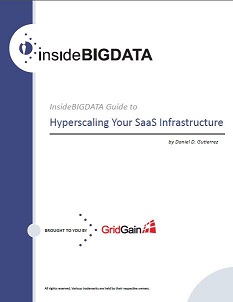This article is the third in an editorial series with a goal to provide direction for SaaS company thought leaders on ways to achieve higher levels of scalability and performance through use of in-memory computing technology.
In last week’s article, we explored the basis for adopting in-memory computing technologies for SaaS applications. The complete insideBIGDATA Guide to Hyperscaling Your SaaS Infrastructure is available for download from the insideBIGDATA White Paper Library.
Benefits to SaaS Companies When Adopting an In-Memory Data Fabric
In this section we’ll explore the important benefits for SaaS companies when adopting an In-Memory Data Fabric.
Addressing one scenario, some SaaS companies having silo deployments and separate deployments per customer may be facing performance issues at a smaller scale which were solved adequately by some in-house solutions like doing application level caching. These same companies now may want to advance up to a SaaS infrastructure and start adding customers based on an on-demand model and scale out to hundreds or thousands of grid nodes—at that point no in-house solution would be acceptable. In this case, turning to in-memory solutions like in-memory data fabrics, and even data grids is a logical choice.
Many SaaS companies are aware of the benefits of caching, and some are using local application level caches. But these same companies now must act due to an expanding customer base, and the need to handle increasing data capacities. It is unlikely that all the data can be loaded into memory on one box, and even if it were possible, one box can’t make calculations in a reasonable period of time. There’s a need to go beyond the box in order to work on large data sets and perform computations in parallel on a cluster. This situation dictates the need to use IMC strategically (as with GridGain’s In-Memory Data Fabric).
At a high level, these companies build silos by customer or by functionality and now want to start breaking those down to have a common platform for everybody and eliminate data redundancy. An In-Memory Data Fabric provides the ability to add customers easily. For many SaaS companies, adding new customers is a new installation—new boxes, new software. If they move to the cloud, adding a new customer might be as simple as creating a new account on the system, or if the system has too many customers, then it might involve starting a new image on Amazon, or a new image on VMware.
One important driver for moving from silo deployments to the SaaS model is the ability to quickly grow and quickly add customers. Products like the GridGain In-Memory Data Fabric, with scale-out capabilities, enable this kind of growth. Many SaaS companies might be at a critical transition-point concerning scalability—how can the business move to the next generation environment? It turns out that an In-Memory Data Fabric is the logical choice as a technology solution to ease this transition.
If you prefer, the complete insideBIGDATA Guide to Hyperscaling Your SaaS Infrastructure is available for download in PDF from the insideBIGDATA White Paper Library, courtesy of GridGain.





Speak Your Mind